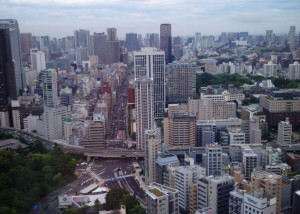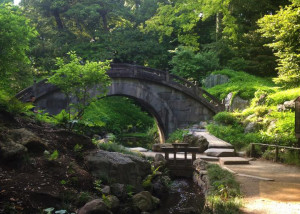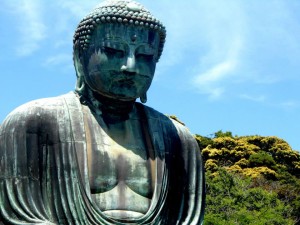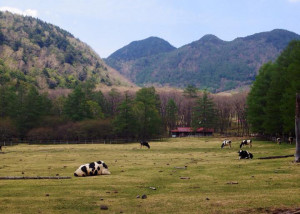What makes music sacred?

Photo: On left, Apollo’s Fire, who perform Bach’s St. John Passion on March 15, 2016. On right, Simon Shaheen, who performs in Zafir on April 15, 2016. Photos courtesy of the artists.
Many people have a “sacred” song—one that especially resonates with or inspires. But what is the meaning of “sacred,” and what about music resonates so deeply? To try to get a sense of the answers to these questions, I asked surveyed a group of University of Michigan students about music that they consider sacred.
For some, a work calls to mind their religious origin and helps them seek a connection with a greater power. Hitomi, recent LSA music graduate, describes her sacred song: “The very first song that came to mind was Ave Maria. I feel that the lyrics evoke spirituality. It’s also a commonly known [religious] piece, so that’s why I associate the melody with connecting with spiritual existence. I experience a sense of serenity and calmness when I listen to Ave Maria. It’s like I’m getting cleansed from all of the negative feelings I might have at the moment.”
For others, like Abigail, a viola performance major, the “sacred” quality of music has to do with the context in which a piece was written. When asked about musical works that are sacred for her, Abigail explains: “Tchaikovsky’s 6th symphony is sacred to me; it’s very emotionally volatile. It’s especially dear to me because it was the last symphony Tchaikovsky wrote before he died, and there’s been so much discussion over what the symphony meant and whether it was a “suicide note.” I feel like the symphony is so emotionally intense that Tchaikovsky definitely had to have been going through something big in his life, but as far as I know, nobody’s really sure exactly what that was. I kind of like the mystery though — it leaves a lot more room for imagination.”
Monica, trumpet player in the Michigan Marching Band, holds a special affinity with the lyrics of her sacred song, Sara Bareilles’s Uncharted. Monica explains, “[The song] is about what to do when confronted with the unknown, when you are afraid of which direction to go in next, and about taking risks for yourself rather than follow what everyone else is doing. My favorite line is ‘compare where you are to where you want to be and you’ll get nowhere.’ [Uncharted is a song] of introspection, agency, and assurance. It suggests that ‘gold’ is not extra valuable just because everyone else seems to want it. Something ‘uncharted’ can be more valuable because you have the opportunity to make it mean as much as you want it to for yourself.”
Some songs are sacred because when we listen to them, they call to mind memories. Penny Stamps School of Art student and acoustic guitar enthusiast Hayden tells the story of her sacred song: “The Moon Song by Karen O made me cry the first time I heard it.” Hayden continues, “I was watching the movie Her on a long flight home from Ireland. I made it my mission to find out what the song [in the movie] was, and to learn it. I don’t really use my ukulele—you’ll usually find me jamming on guitar—but I picked it up so I could learn the Moon Song. [The song is] not even in my vocal range, but it gives me the warm fuzzies whenever I play it. I think that I like it so much because it brought me a dose of joy when I was sad to be a leaving a place where I wanted to stay, and on a mode of transportation that scares me to death. [The song] has that same dose of joy every time I plunk it out on my ukulele.”
Ryan, bassoon player in the Akropolis String Quartet, recalls the childhood memory tied to his sacred song, I Believe I Can Fly by R. Kelly. He says, “This might be a strange choice, especially because I will admit to knowing very few of the lyrics (just the famous chorus), and I haven’t listened to the studio recording of it in years. But, I associate that song with my deep childhood love of the movie Space Jam, starring Michael Jordan and Bugs Bunny. That movie taught me, in equal importance, the necessity of hard work and joy in the pursuit of my dreams (at the time, a career as a basketball player, but eventually music…). Since, the song has become a mental soundtrack much of the work I’ve put forth in life, and I have probably song the chorus out loud in front of people more than anything else I’ve ever heard. Sometimes I sing it in jest, sometimes I sing it sincerely—in private of course.”
Music can be sacred for many reasons. From Bach’s St. John’s Passion performed by Apollo’s Fire to the music of Andalucia in Simon Shaheen’s Zafir performance, there are many definitions of the sacred to explore through UMS performance in the upcoming season.
What’s your “sacred” music? What makes it sacred for you?
Student Spotlight: Rachel Stopchinski on Japan and Sankai Juku
Editor’s note: Rachel Stopchinski is a student at the University of Michigan and part of our UMS student intern team. This summer, Rachel traveled to Japan as part of a study abroad program through the University of Michigan. Her travel blog follows, and her experiences include reflections on Sankai Juku, a Japanese dance group performing in Ann Arbor this October.

Photo: A moment from UMUSUNA: Memories Before History, a work by the Japanese company Sankai Juku, who perform in Ann Arbor October 23-24, 2015. Photo courtesy of the artist.
This past May, I had the opportunity to travel to Tokyo, Japan, my second study abroad program in my undergraduate years. This program followed a class I’d taken on Environmental History. As part of the class, my classmates and our professor were going to participate in experiential learning and exploration. After studying in Tokyo for a month the year prior, I was excited to see what adventures this trip would bring me. However, I knew that neither of these trips would’ve been possible without my exposure to international theater through my internship in the UMS ticket office.
Inspired to Learn by Performance
In its 2013-2014 season, UMS presented Complicite’s A Portrait of Shun-kin, a contemporary theater work. While working in the ticket office, students familiarize themselves with upcoming performances. A Portrait of Shun-kin was one of those performances that seemed so unusual that I had to attend to grasp what it was about. Based on Tanizaki Junichiro’s novella of the same title, the performance was performed in Japanese by the Setagaya Public Theater with English subtitles and made heavy use of puppetry and highly-contrasted stage lighting. Although the performance was three hours long, I didn’t notice time passing and was spell-bound by the performance’s intensity. I walked away that night painfully aware of how little I knew about the world and of the small scope of literature that had been covered in the English courses I’d chosen so far. Coincidentally, this is when I heard about a new study abroad program focused on reading modern Japanese literature in translation…It was fate. Had I not had that exposure through A Portrait of Shun-kin, I don’t believe I would’ve found myself in Tokyo that following year with a growing interest in Japanese culture and history. In literature, context is everything, and I wanted to explore Japanese history in a practical way.
Left: Daibutsu at Koto-kuin, a Buddhist Temple in Kamakura, Japan. Right: A view of the seaside in Kamakura, Japan.
Returning to Tokyo
For me, returning to Tokyo for the second time brought the realization that while one may leave a place, one never really forgets it. I’d spent my time on my first trip freely exploring the city, so during the second trip, I easily adapted to using the trains and metro again. (I even felt a little nostalgic.) But though my directional memory was spot on, the second trip came after one more year of learning about Japan, so I viewed the city through a different lens.


Left: The Tokyo skyline as seen from Tokyo Tower contrasted with Right: A serene bridge inside Koishikawa Korakuen, a traditional Japanese garden in Tokyo.
Through my Environmental History course, we studied the effect of environmental issues on Japanese culture and history over time. During my time in Japan, we interacted with many people, from university students to filmmakers, non-profit organizations, and even government officials at a waste processing site, all with the purpose of learning about the environmental issues. During the program, we moved to and from the countryside, meeting guides who taught us about the unique history and traditions of the places we visited and highlighted the longstanding relationship with the environment, both its great beauty and the effects of devastating pollution and disasters. We explored the harmony and disharmony between humans and nature.
Left: A pastoral scene found while hiking in Nikko, Japan. Right: Basking in the beauty of Lake Chuzenji from a swan boat.
Back to Performance
When looking at the description for UMS’s upcoming presentation of Sankai Juku’s UMUSUNA: Memories Before History, I think about hiking in ancient, old growth forest in the “sea of trees” at the base of Mt. Fuji. My class was spending the weekend in Fujinomiya, Japan at the Whole Earth Nature School, an organization that facilitates groups in “ecotourism.” Our guides, Michi and Musashi, stressed the importance of engaging with the environment, so while we learned about Mt. Fuji as an active volcano and this history of the plant growth form observation, we got dirty, hugged a few trees, and went caving as well.
I’m not sure that we could have been prepared for the ice in the cave. Everything from the floor to walls to ceiling was covered with a thick layer of ice. We tried to avoid it but conceded to sitting down and sliding throughout. It was a challenging experience. We tried our best to work as a team to identify those least icy parts. When we reached a clearing in the cave, we turned off our head lamps and sat in darkness, deep below the earth we had once stood on. Climbing out of the cave, we moved from darkness to light and the most vivid colors I’d ever seen. I won’t forget both the reverence I felt in that cave and the joy upon reaching the surface.
Butoh performance, like Sankai Juku’s UMUSUNA: Memories Before History, which plays at the Power Center this October, often aren’t narrative. The symbolism of their intense movement vocabulary is left for the audience to decipher. I expect this performance will call to my mind my experiences both in the forests of Mt. Fuji and elsewhere, experiences that attempted to illuminate the complex relationship between Japanese culture and the environment. We interacted, even climbed inside, the earth. We wondered what it would have been like before human interaction—a history we can only imagine.
Interested in more? From our archives, backstage with Sankai Juku.
What are the different kinds of marching bands?
Marching bands are prevalent in modern American society, from ushering in the beginnings of parades to entertaining the masses during football game halftime shows.
Did you know that there are many variations of marching band, each with their own style and traditions? Find out what makes a marching band.
1. The Military Band
The modern marching band originates in the military band tradition. Military bands are characterized by straight, organized ranks that move in the forwards direction. Clean and precise, military bands put a heavy emphasis on the uniformity of their visual style. Military bands often play national or patriotic tunes. The art of the military band isn’t as popular as it was, but some do exist, notably the Texas A&M Fightin’ Texas Aggie Band, the largest military style band in the country. In addition, many United States military bands form marching ranks for particular occasions, such as inaugural parades.
2. The Drum and Bugle Corp
Other styles of marching band borrow elements from the military band, but add their own unique flair. For example, the Drum and Bugle Corps borrows elements of the military’s regimented nature, but make formations that can be more organic and even pictorial. In addition, Drum and Bugle Corps freely move both backwards and forwards. Band members often “traverse” or “slide” so that their upper bodies consistently face the front of the field, ensuring a constant wall of sound no matter what direction they move. These elements can be manipulated to create various effects in dynamics.
Drum and Bugle Corps aim to imitate the artistic sound of a concert band while on the move. These bands put together one show, with a set list of music, based around a theme, which they practice and perform over the length of the season. Their repertoire can vary from classical to jazz to even movie scores. Most bands of this style consist of only brass, percussion, and a color guard, giving them a unique, rich sound due to the absence of the woodwind section.
Drum and Bugle Corps represent the competitive aspect of marching band culture. Many participate in circuits, like Drum Corps International (DCI), where bands compete against one another. Fans of these circuits often loyally support their favorite Drum and Bugle Corps like one would a sports team. Hardcore fans of DCI are known to enter lively debates over which Drum and Bugle Corp is the best of all.
3. The Marching Band
However, probably the most prolific in popular culture is the college marching band, seen performing at halftime at most football games across the United States. These marching bands might put a heavy emphasis on crowd entertainment and sometimes scripted storytelling.
Each band cultivates their own visual style and sound. While some model the Drum and Bugle Corps, others are starkly different, holding true to the regimented tradition of the marching band, but also embracing edgier sounds and contemporary music. All-band dance breaks or the use of props and effects are becoming more common. The repertoire played is catered to the crowd and features popular or radio music. While instrumentation is up to the discretion of the band, most feature full woodwind, brass, drumline, and color guard sections.
In addition, many bands use a high step style either in replacement or addition of the typical roll/glide step seen in Drum and Bugle Corps. This involves band members raising their steps at an angle, though the steps vary based on the traditions of the band.
Details aside, the main goal of these marching bands is to give the audience the best possible experience while anxiously waiting for their football teams to return to the field. One great example is the University of Michigan’s own marching band, The Michigan Marching Band (MMB). From Beyoncé to Willie Wonka to a collaboration with Pixmob, the MMB strives to bring the most innovative in halftime entertainment to the Big House’s 100,000+ crowd every football Saturday. The excitement as the MMB takes the field is palpable for both the musicians and the audience!
4. The Party Band
Lastly, there are many marching bands that exist outside these categories. The Detroit Party Marching Band, for example, carries the spirit of entertainment embraced by many modern marching bands, but with none of the formalities. Jamming to arrangements of popular music, members openly groove and dance as they play. Less attention is placed on the precision of visual style and more is placed on the creation of fun, lighthearted atmosphere. They frequent city streets, standing in a huddle or moving around, ready to start an impromptu party. They capture the spirit of camaraderie and showmanship embraced by the marching band community without the restrictions of the formalities of organized movement. Party bands can perform / party in non-typical venues, and their memorable, laidback attitude draws people to them in flocks.
Do you love marching bands? Are you in a marching band? Share your thoughts and stories in the comments below.
Updated 6/2/2017






